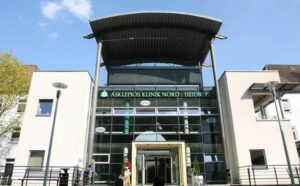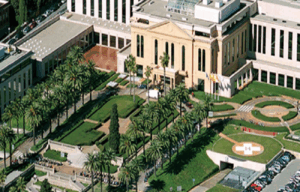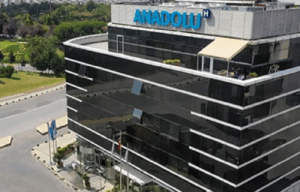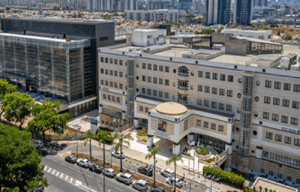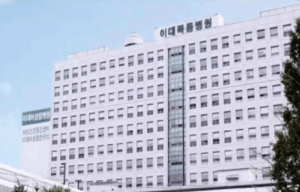Cerebral Aneurysm
Disease description
A cerebral aneurysm is a localized bulging of a brain artery wall caused by its weakening. While many aneurysms remain undetected throughout life, a ruptured aneurysm can lead to serious consequences, including subarachnoid hemorrhage, stroke, and even death. Statistics show that approximately 1 in 50 people has an unruptured cerebral aneurysm, most of which remain asymptomatic.
Symptoms Requiring Diagnosis and Treatment:
- Sudden, severe headache (often described as a “thunderclap” headache)
- Blurred or double vision
- Eye pain or changes in pupil size
- Numbness or weakness on one side of the face
- Nausea and vomiting
- Loss of consciousness
Diagnostic and treatment methods
Diagnosis
Diagnosis begins with an emergency computed tomography (CT) scan of the brain, especially if rupture is suspected. CT angiography (CTA) or magnetic resonance angiography (MRA) provides more precise visualization of the aneurysm, determining its size, shape, and location. In some cases, cerebral angiography (DSA) is used to obtain detailed images of brain blood vessels.
Treatment
The management of cerebral aneurysms is contingent upon their size, anatomical location, and rupture risk profile. For small, asymptomatic aneurysms, surveillance with periodic imaging follow-up may constitute the recommended approach. In cases demonstrating elevated rupture risk, endovascular intervention is typically employed, utilizing coil embolization or stent placement techniques to reinforce the vascular wall and prevent hemorrhagic events. When endovascular modalities prove contraindicated or technically unfeasible, open microsurgical clipping remains the definitive treatment option.
Innovations in global clinics
Contemporary neurosurgical practice has witnessed the advent of novel endovascular technologies, including flow-diverting stent grafts, which significantly mitigate rupture potential while optimizing patient recovery timelines. Parallel developments in molecular therapeutics are emerging, focusing on arterial wall stabilization and aneurysm growth inhibition through targeted biological pathways.
Top clinics
-
 Duisburg, Germany Duisburg-Nord Hospital
Duisburg, Germany Duisburg-Nord Hospital -
 Seoul, South Korea Asan Medical Center
Seoul, South Korea Asan Medical Center -
 Jerusalem, Israel Hadassah Medical Center
Jerusalem, Israel Hadassah Medical Center -
 Petah Tikva, Israel Medical Center “Rabin”
Petah Tikva, Israel Medical Center “Rabin” -
 Istanbul, Turkey Medipol Mega University Hospital
Istanbul, Turkey Medipol Mega University Hospital -
 Istanbul, Turkey Istanbul Florence Nightingale Hospital
Istanbul, Turkey Istanbul Florence Nightingale Hospital -
 Geneva, Switzerland Hirslanden Clinique La Colline
Geneva, Switzerland Hirslanden Clinique La Colline -
 Geneva, Switzerland Generale-Beaulieu
Geneva, Switzerland Generale-Beaulieu -
 Istanbul, Turkey Acibadem Altunizade
Istanbul, Turkey Acibadem Altunizade -
 Istanbul, Turkey Acıbadem Ataşehir Clinic
Istanbul, Turkey Acıbadem Ataşehir Clinic -
 Antalya, Turkey Hospital Medical Park Antalya
Antalya, Turkey Hospital Medical Park Antalya -
 Dubai, UAE NMC Healthcare
Dubai, UAE NMC Healthcare -
 Istanbul, Turkey Hospital “Memorial Şişli”
Istanbul, Turkey Hospital “Memorial Şişli” -
 Milan, Italy San Raffaele University Hospital
Milan, Italy San Raffaele University Hospital -
 Abu Dhabi, UAE Burjeel Hospital Abu Dhabi
Abu Dhabi, UAE Burjeel Hospital Abu Dhabi -
 Vienna, Austria Debling Private Clinic
Vienna, Austria Debling Private Clinic -
 Heidelberg, Germany Heidelberg University Hospital
Heidelberg, Germany Heidelberg University Hospital -
 Hamburg, Germany Asklepios Nord Heidberg
Hamburg, Germany Asklepios Nord Heidberg -
 Istanbul, Turkey “Memorial Bahçelievler” Clinic
Istanbul, Turkey “Memorial Bahçelievler” Clinic -
 Incheon, South Korea Gil Medical Center at Gachon University
Incheon, South Korea Gil Medical Center at Gachon University -
 Nyon, Switzerland Clinique Genolier
Nyon, Switzerland Clinique Genolier -
 Istanbul, Turkey “Memorial Ataşehir” Clinic
Istanbul, Turkey “Memorial Ataşehir” Clinic -
 Antalya, Turkey Memorial Antalya Hastanesi
Antalya, Turkey Memorial Antalya Hastanesi -
 Barcelona, Spain QuironSalud Barcelona Hospital
Barcelona, Spain QuironSalud Barcelona Hospital -
 Barcelona, Spain Medical Center "Teknon"
Barcelona, Spain Medical Center "Teknon" -
 Barcelona, Spain Sant Joan de Deu Children's Hospital
Barcelona, Spain Sant Joan de Deu Children's Hospital -
 Barcelona, Spain University Hospital Barnaclinic+
Barcelona, Spain University Hospital Barnaclinic+ -
 Gebze, Turkey Anadolu Clinic
Gebze, Turkey Anadolu Clinic -
 Zurich, Switzerland Hirslanden Clinic
Zurich, Switzerland Hirslanden Clinic -
 Petah Tikva, Israel Schneider Children's Medical Center
Petah Tikva, Israel Schneider Children's Medical Center -
 Seoul, South Korea Samsung Medical Center
Seoul, South Korea Samsung Medical Center -
 Seoul, South Korea Medical Center at Ewha Womans University
Seoul, South Korea Medical Center at Ewha Womans University -
 SNUH
SNUH

















